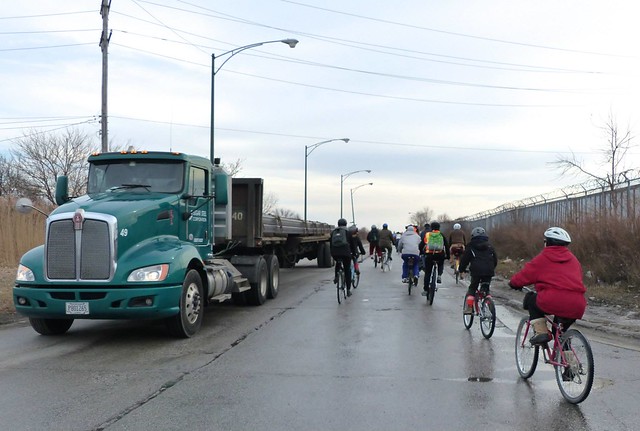[The Chicago Reader recently launched a new weekly transportation column written by Streetsblog Chicago editor John Greenfield. This partnership allows Streetsblog to extend the reach of our livable streets advocacy. We syndicate a portion of the column on the day it comes out online; you can read the remainder on the Reader’s website or in print. The paper hits the streets on Thursdays.]
Last week I rode the Red Line to 95th Street with my cruiser bike in tow, then pedaled about six miles to the future site of Big Marsh Bike Park, just east of Lake Calumet. Boosters say it will be a world-class, family-friendly venue for BMX riding, mountain biking, and cyclocross racing that will also provide recreational and economic opportunities for residents of low-income southeast- side neighborhoods near the park.
The bike park will lie within Big Marsh, a 278-acre expanse of open space that the Chicago Park District acquired in 2011. Environmental remediation is currently under way, since the area was formerly a slag-dumping site for steel mills, and the Park District expects the facility will open in late fall.
But my ride from the el station would have been traumatizing for novice cyclists. It was comfortable at first—a bike lane led south on State Street, then another took me east on 103rd. But after I passed under the Metra Electric tracks at Cottage Grove, the bike lane disappeared and 103rd ballooned into a four-lane highway with fast traffic, including several 18-wheelers.
Next I rode south on Stony Island toward Lake Calumet, but things weren't much better on that stretch of road. Although Stony and Doty, the two streets that circle the lake, offer scenic views of the remediated landfill, with its tallgrass, ponds, and a variety of wild birds, they're also frequented by fast-moving trucks headed to and from industrial businesses. I got spooked by a huge gas tanker thundering by even though I spent six years of my life working as a bike messenger on the mean streets of the Loop.
Getting to Big Marsh is equally arduous if you're coming from the Roseland and Pullman communities to the west, the East Side, South Deering, and Hegewisch neighborhoods to the east, or the Altgeld Gardens housing project to the south. There is no direct transit access to the park, although several CTA bus lines terminate at a bus garage a 2.5-mile bike ride from the park.
While the bike park should attract cycling aficionados from across the city and the region, for it to succeed in its mission of revitalizing the surrounding communities it also needs to be accessible to all nearby residents, including those who don't drive.
"Friends of Big Marsh doesn't just want to be the friends of people who drive 45 minutes with their multithousand-dollar bikes to ride the trails," says Steve Buchtel, a member of the coalition that supports the development of the park, who also leads the advocacy group Trails for Illinois. "We also want to create a world-class park experience for the people who live close by."
Last year Oboi Reed, cofounder of Slow Roll Chicago, which promotes cycling on the south and west sides, told the Chicago Tribune that the access problem is also an equity issue. "The idea that people can just drive there is exclusionary," he said. "Many low-income people don't own cars." (Reed is also a Streetsblog Chicago board member.)
Fortunately the access problem seems to be on the city's radar. While CTA spokesman Jeff Tolman said there are no plans for direct bus service to Big Marsh, the Chicago Department of Transportation's Mike Claffey noted that the department has been working with residents and community leaders to identify priority bike routes on the far south side. At bikeway hearings in the East Side and Pullman last month, residents made it clear that they want safe routes to the bike park and let CDOT know which streets they'd like to see improved.






